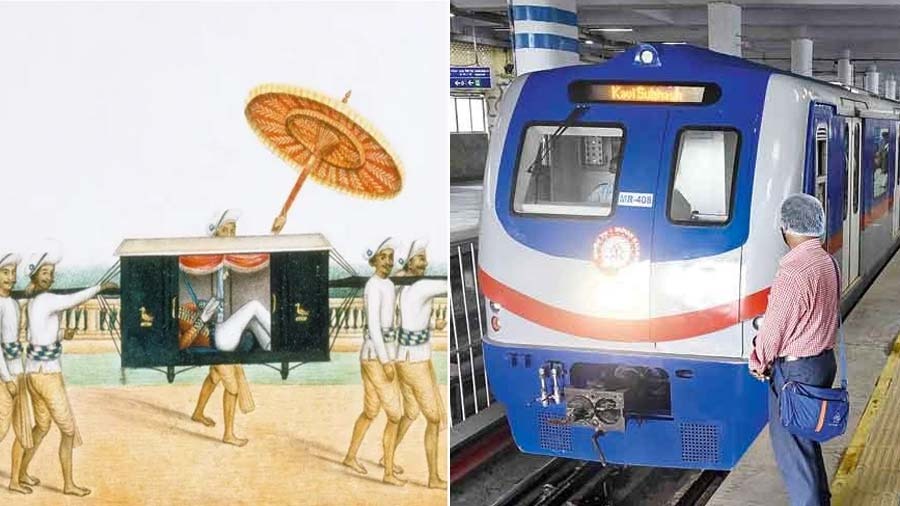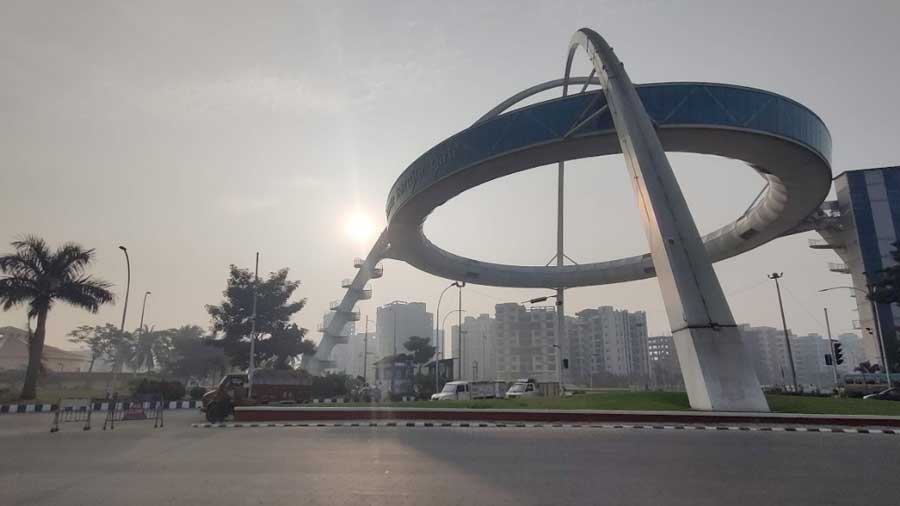Despite a line of urban transit systems and booming automobile trends, remnants of old-time commutes remain visible all around Kolkata — be it the vintage car rallies, the hand-pulled rickshaws or the iconic yellow taxis. The city that was once a British capital has stood witness to the first run of many new transportation options, be it the first motor car in India or the first Metro Railway.
Radharaman Mitra in his book Kolikata Darpan states that Circular Road was the first big road that developed in Kolkata and it was not only the first boro rasta (main road) in the city but the first pakka rasta (concrete road) too.
Here’s a closer look at the many modes of transportation Kolkatans have availed through the decades…
Palki
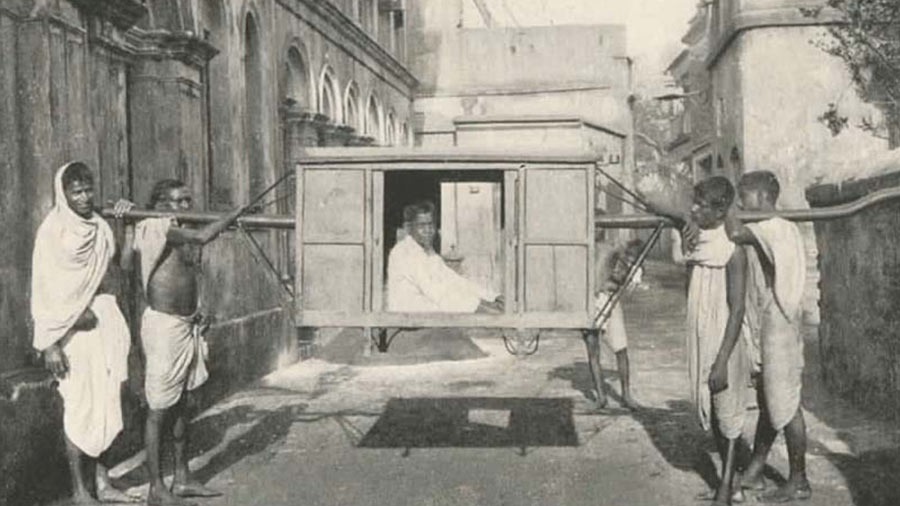
Wikimedia Commons
The palanquin, or palki, was one of the first modes of transportation in the city. Though bullock carts were quite common, they were restricted to villages. From aristocratic women and newlywed brides to officials of the British government, the palki was used by city dwellers from many walks of life. The use of the palki can be traced back to the beginning of the 18th century.
Though records suggest horse-driven carts were in use, palkis were still a crucial mode of transport for the aristocracy. In Tagore’s Birpurush (1903), for instance, the child imagines travelling with his mother, and the latter is said to be seated in a palki. The painter Shaikh Muhammad Amir who worked in the mid-1800s was famed for a celebrated portrait of a sahib being carried through Calcutta in a black, oblong palanquin.
Mentions of palki are scattered across Bengali literature, be it Leela Majumdar’s Podpishir Bormi Baksho or Abanindranath Tagore’s Khirer Putul.
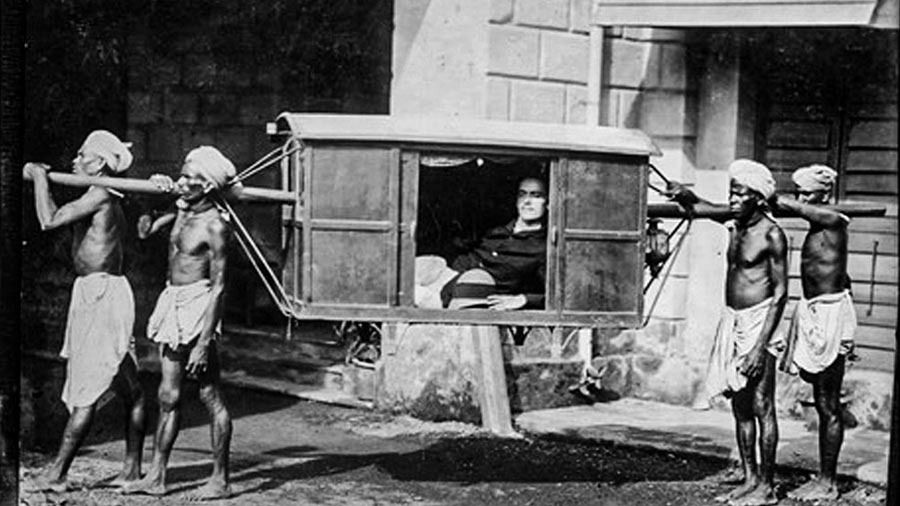
TT archives
People started keeping personal palkis as well and rental options were also available in the 19th century. The affluent even spent up to Rs 3,000 (quite an amount back then) to make customised palkis. The palki was not only a major means of transport in Kolkata, but also became a status symbol for the maharajas, the East India Company officials and the affluent.
Reports also show that in 1827, palanquin carriers called for a dharmaghat, or strike, which meant there were enough carriers to stage a successful protest.
Ghorar Gari/ Carriages

The British population residing in Kolkata used five kinds of transport — carriages, palanquins, palki gari, Brownberry cart and buggy. Carriages were used by the higher officials of the East India Company. They were often used for leisurely rides in the evenings. The carriages were pulled by horses and were accompanied by riders, mounted attendants and coachmen.
The palki gari had doors with latches and were pulled by two horses. These were accompanied by two mounted attendants and foot attendants, who had to run with the horses.
The small palki gari did not have any doors, but shutters like a palanquin, which could be opened by hand. The Brownberry carts, which had four small tyres under the cart and were drawn by a horse, were made by an Englishman named Brownlow around 1829.
Next were buggy carts. They were light, hooded carriages that were typically drawn by one or two horses. A number of horse-drawn carriages emerged on the streets of Kolkata during this time, like the Greenfield, Office Jaun, Hackney carriage and many more. Phaetons emerged as a prestige carrier. Other names included Brougham, Landau, Barouche and Gigant.
These were all horse-drawn carriages that were visible on the streets of Kolkata and had wheels made of iron, as rubber tyres were only introduced around 1900. You can experience a taste of this old-world transport with the Victoria carriages near Red Road.
Tram

TT archives
Tram carriages were originally drawn by horses. Electric trams came in much later. At first, trams were designed to carry only goods. The first track was laid from Sealdah to Armenian Ghat. According to author Radharaman Mitra, the first-ever tram service began on February 24, 1873. However, huge losses were incurred and the service came to a halt within just nine months.
In November 1880, trams started running on the Sealdah, Bowbazar, Dalhousie and Hare Street route. The other tram routes through Chitpur, Kidderpore and other locations became functional within the next three to four years. The tram drivers and conductors did not wear the khaki uniform that we see them donning now. Instead, they wore red pagris, and the trams were painted with a colour called CTC grey.
In 1902 the first electric-driven tram ran on Kolkata streets, on the Kidderpore line.
Bicycles
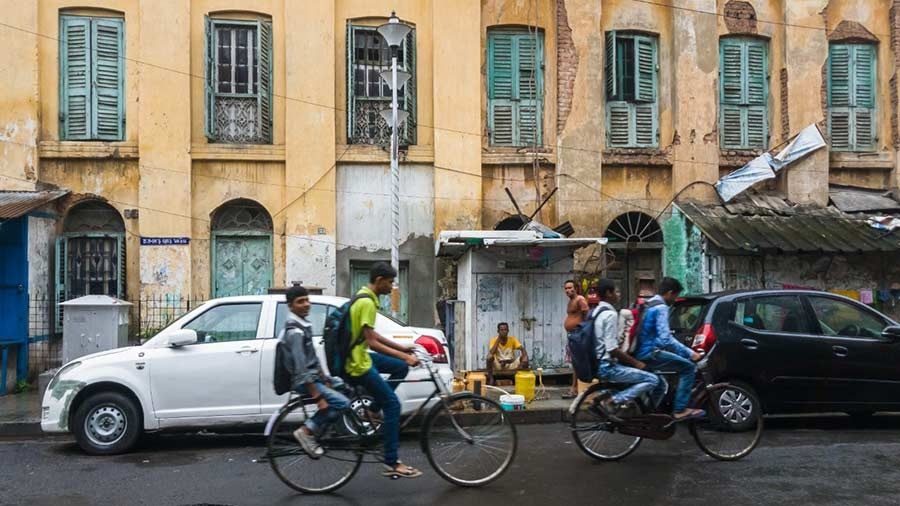
Cycles became a common and accessible mode of transportation, used by people from all walks of life, by the mid-1900s Shutterstock
From the milkman to paperwalla — this means of transport is still indispensable to many in the city, and India as a whole. However, the history of bicycles on the roads of Kolkata is not as clearly defined. Velocipedes (a vehicle made of wood with two wheels but no pedal) were visible in the Dalhousie area around the 1820s.
But Kolkata got to see its first ‘modern’ bicycle in 1889, thanks to Hemendra Mohan Bose, according to Radharaman Mitra. Other sources state that it was in 1886 that Kolkata got to see its first bicycle, when Thomas Stevens, the man who set out on a world tour in 1884 from San Francisco, arrived in Kolkata.
By the mid-1900s, the cycle was a common and accessible mode of transportation used by people from all walks of life. The popular Byomkesh novel Pather Kanta, which was published in the 1930s, used the bicycle bell as a crucial plot device, indicating that the vehicle had indeed become quite commonplace.
Motor Cars
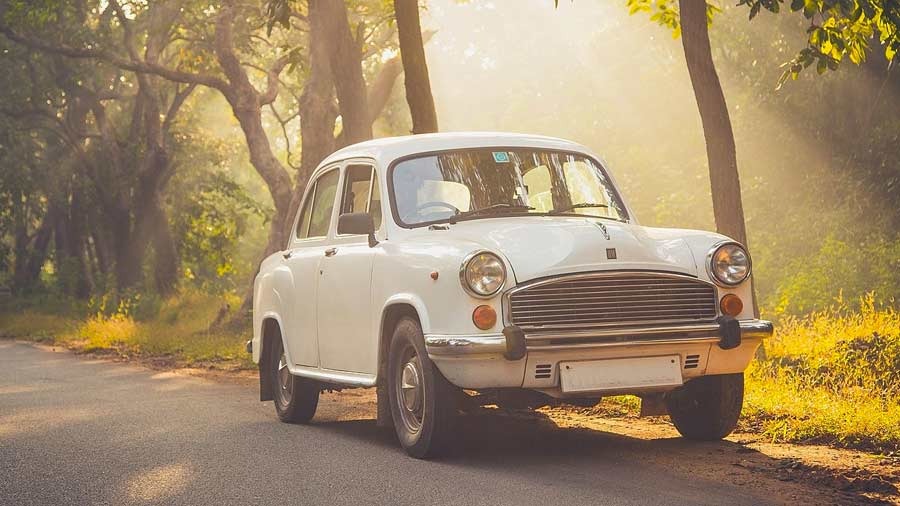
The iconic Ambassador — the first motor car manufactured in India Wikimedia Commons
The history of the motor car in Kolkata goes back a long way. It was around 1896-97 that the first car was seen on the streets of the city. It was here that the first-ever motor car was launched in India — most likely by a French manufacturer named De Dion-Bouton. Cars became so popular that even zamindars started buying them. However, big prestige cars didn’t exactly pave the way for motoring culture like smaller models did, like the Humber, for instance.
Though Hindustan Motors was established in the pre-Independence era at Port Okha in Gujarat; in 1948, operations were moved to Uttarpara in Hooghly, where the company began the production of the iconic Ambassador — the first motor car manufactured in India
Bus
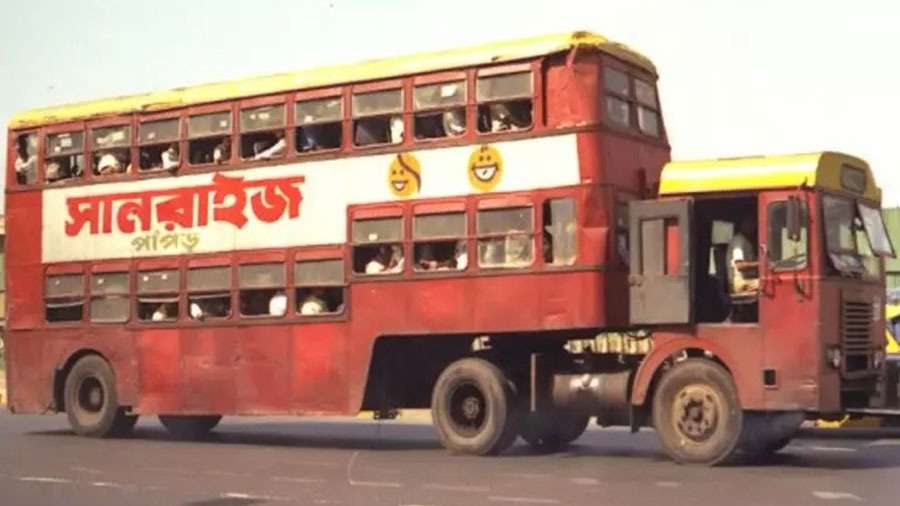
A double-decker bus in Kolkata in the ’90s Pinterest
It was in 1830 that the first horse-ridden bus was seen on the streets of Kolkata. In 1922, the first motor bus plied the streets with passengers. The buses didn't have numbers initially but had very interesting names like Menoka, Kinnari, Pather Bondhu etc. Then came the red buses of the Walford Company.
The first double-decker bus in Kolkata was brought by them too, around 1926. In fact, a double-decker bus dubbed Albert ferried passengers between London and Kolkata in the late 1960s and early 1970s. The trip took more than 50 days and cost £145. The bus travelled across nine countries and had bunk beds and heaters.
Though double-decker buses vanished from the roads in Kolkata around 2005, the state government revived the iconic buses by introducing open-air, vibrant, blue double-decker buses in 2020.
Rickshaw
The birthplace of the rickshaw is believed to be Japan where it’s commonly known as Jean-Ri-Ki-sha. From Japan, it travelled to Shanghai and by 1880 rickshaws had come to India. Back then they were known as Jenny Rickshaw or Jean Rickshaw.
Around 1900 some Chinese residents in Kolkata imported rickshaws for their personal use. The rickshaw pullers were also Chinese. By 1913-14 locals had started commuting by rickshaw. By 1920 Chinese rickshaw pullers were replaced by the natives and the rickshaws became a popular conveyance for hire. It was with the introduction of the rickshaw that the palki started to fade away from the streets.
The hand-pulled rickshaws were eventually replaced by cycle-style carts with hoods. Hand-pulled rickshaws, long associated with the city’s imagery, still exist in parts of Kolkata.
Taxi
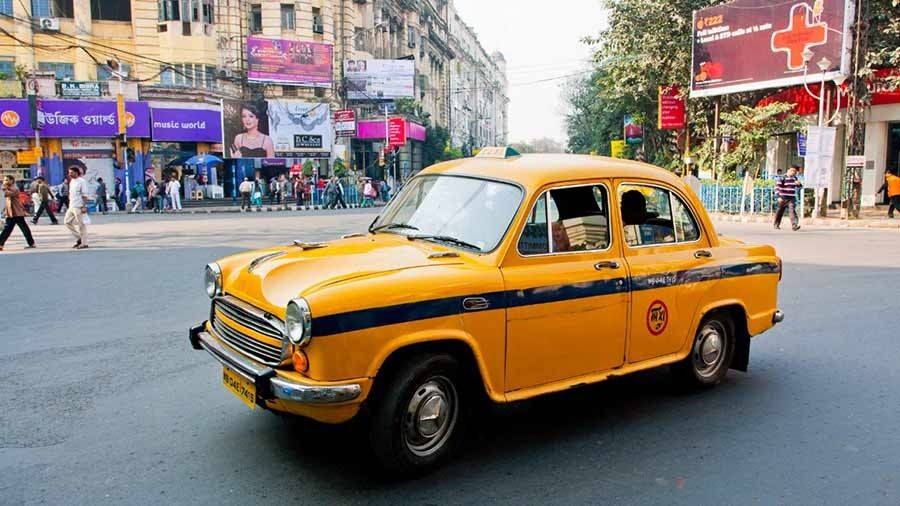
Shutterstock
The very first taxi appeared in Kolkata in 1906 and the first taxis belonged to ‘A’ company (the company had 80-90 taxis, all marked with an A). The drivers were paid good wages and worked under a commission system. It was almost similar to the modern-day mobility service providers like Uber or the Ola taxis, although the system of booking was different (what with no GPS or Internet).
But the taxi drivers were so well-versed with every lane and bylane of the city, they were no less than a human GPS! The iconic Ambassador model came in around 1962. While one featured a yellow and black combination, the other one was solid yellow. The yellow ones were for inter-city commute while the yellow-black ones plied only within the city.
Modern-day Kolkatans share a love-hate relationship with the yellow taxis, even more so after the arrival of Ola and Uber. The modern services are more readily accessible than yellow cabs and unlike the latter, Uber or Ola drivers are not quite so averse to travelling long distances.
Metro
With the introduction of Metro Rail, the entire concept of transportation changed in the metropolis. Within minutes one could reach from one corner of the city to the other, and that too, without burning a hole in their pockets! This rapid transit system made the city much more exuberant, open and full of prospects. The underground mode of communication started in 1984. The Kolkata Metro is the first planned and operational rapid transit system in India.
The master plan of the Metro corridor was made in 1971 along with the North-South Corridor and by 2011–2012, the railway ministry had announced plans for the construction of five new Metro lines, connecting areas like New Garia to Dum Dum, Joka to BBD Bag and so on.
